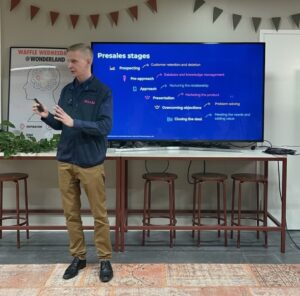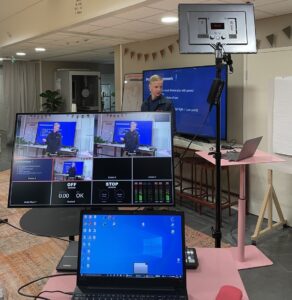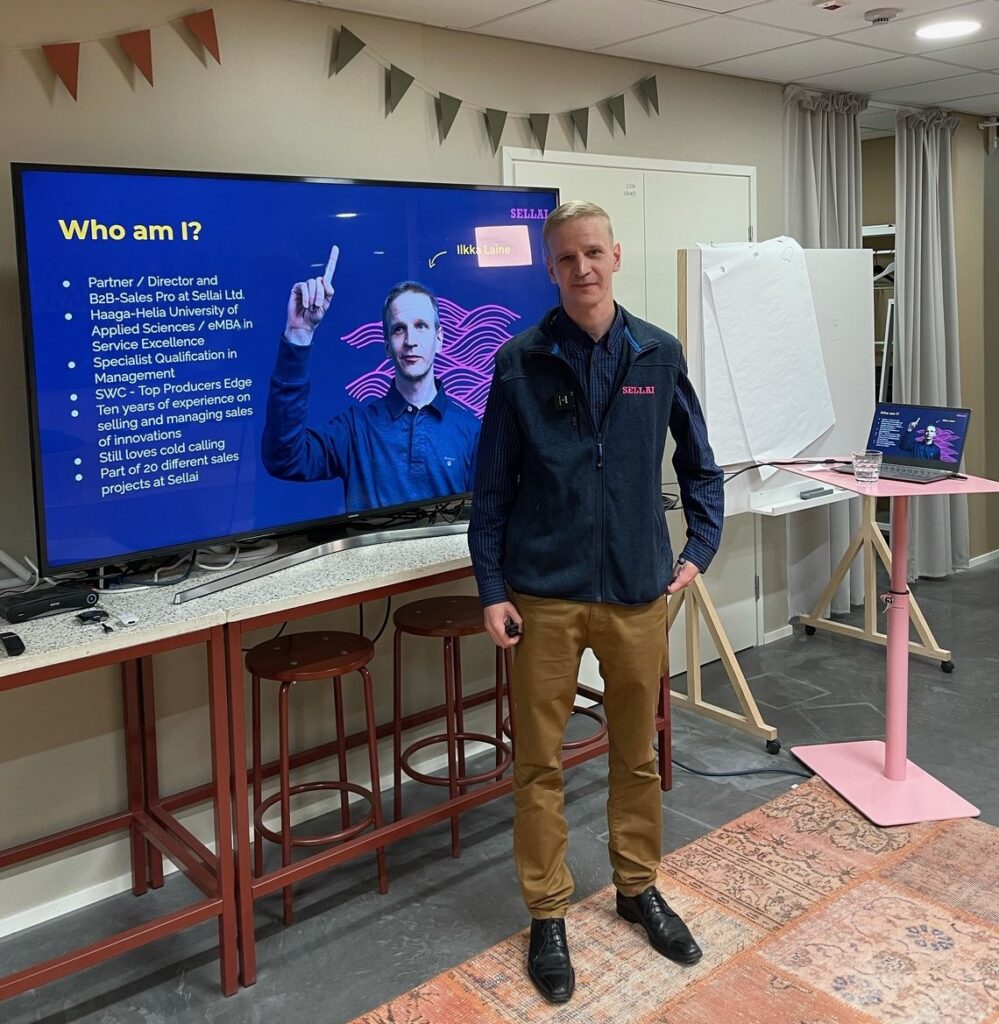Waffle Wednesday 13.10. was held in Wonderland Vallila where Ilkka Laine came to give a speech about consultative B2B sales. He is a director at Sellai Oy as well as a shareholder and a B2B sales pro. Sellai Oy is an organization that specializes in advanced B2B sales. You can get a team of experienced sales consultants as a monthly service from them. So they do modern sales outsourcing utilizing modern technology and operating models. Wonderland has been Sellai Oy’s homebase for 3 years now.
Laine himself has worked with sales for about 10 years. He has sold innovations that no one has ever sold before. So one could describe him as a pioneer sales agent. Even after ten years, Laine still loves cold calling. Cold calling means making sales calls that have not been prearranged. Cold calling is one of the key factors of successful sales.
Autonomy and self-discipline
”No time to make sales”
Nowadays we have a lot of distractions around us in our work life. Social media, entertainment and other nice things that are happening around us are constantly fighting for our attention.
In addition to the distractions, it is also easy to hide behind excuses. ”It’s hard to make sales because of the pandemic” – ”Well no shit”. Of course it makes selling a lot more difficult. But that is no reason to do nothing. If you just wait for the pandemic to be over your business will be dead before that.
Other common excuses are for example ”I don’t have time for it”, ”I don’t have the right colleagues around me” or ”I need more information before I can do this”. Overanalyzing the challenges can easily lead into paralysis and not getting anything done.
Tools for selling
There are a lot of good tools that can make selling easier. Tools that you can find client information with, CRM tools, communication tools, social media channels, document signing tools… you name it.
Nowadays we have thousands of ways to improve ourselves and learn new things on the internet. You can for example attend different academies’ online courses. But it’s important that you don’t only learn new things but can also use the things you learn to your advantage. The key is to first internalize the learnings and then externalize them. When you utilize the things you have learned at work, you bring more value to your company and therefore more value to the customers.

Presales stages
Your businesses can be unique and your solutions can be unique as well however sales work rarely is. Laine shared with us the 7 presales stages that they have identified.
- Prospecting -> Customer retention and deletion
”We have identified that if a sales agent is only working commission based they will do deals that don’t bring any value and that will eventually end within a year.” This is because they will get paid only by making the deals so they don’t care to actually bring value to the client.
In order to have good customer relationships you have to be able to recognize which ones are the right customers for your company and the ones you want to hold. When you recognize that somebody is not your type of client it is important to also leave “a beautiful exit”. This means that you leave the client with a good experience even though you didn’t end up making the sale. This is how you create a good reputation for your company and the person may even recommend you to someone he knows that needs similar services.
Acquiring new clients is really expensive compared to keeping old clients happy. This is why hunting-based sales work can be hard and may lead into big problems.
- Pre-approach -> Database and knowledge management
It’s good to know which is the right channel to contact the decision makers through. It’s also important to document everything, like for example the times you have tried to reach decision makers. You can gather that if you have called 5 times to the same decision maker, the 6th call probably won’t make any difference.
Next time you can try sending an email or contacting the decision maker via LinkedIn. Or maybe next time it would be wiser to try to reach some other decision maker.
Another reason for documenting is that we want to learn about the end client’s buying process. We may have our own selling process ready but we have to respect the way the client wants to buy. The clients usually have a specific time slot in which they are ready to buy and their decisions usually include many decision makers. By documenting everything we remember when and how the clients wanted us to contact them. Respecting the client’s wishes helps to build and maintain a good customer relationship.
- Approach -> Nurturing the relationship
Nurturing the customer relationship includes ongoing communication with the client.
- Presentation -> Marketing the product
How do you present your solution and the value you can bring to the client?
- Overcoming objections -> Problem solving
We need to be able to see things from the client’s perspective. We need to understand why they are asking something and why they see something as an obstacle. This is how we can better meet the client’s needs. The point is not to just give some quick answer to the clients’ questions that will make sales but to actually do the background research and figure out how we can actually help them.
It’s good to also acknowledge that you are most likely not the only company that offers those solutions to the client’s problems. It’s worthwhile to think about how you can differentiate from the competitors that offer similar solutions. And as mentioned previously, it is important to be able to recognize the clients that may need your services. It’s only a waste of time to try to turn around someone’s head that clearly doesn’t need anything from you.
- Closing the deal -> meeting the needs and adding value
Bringing added value to the clients is an essential part of the sales.
- Follow-up
If you have collected enough data you are able to serve the clients on platforms that they wish to be served and in the time that they make decisions. It’s also important to have a relationship with the company and not just one decision maker. That way if the decision makers of the company change, you will still have the relationship with the company.

Healthy pipeline FTE
Pipelines can vary a lot from company to company and there is no one right way to do it. However Laine shared with us their example of a healthy pipeline. Their pipeline shows how disciplinary the work should be and how you should set up your goals. Every sales company should have some goals like for example how many calls and meetings there should be in a week. These also need to be documented well.
6 steps of the pipeline:
- Background information research – Databases, different tools and background information systems that are easy to automatize.
- Buying personas – for example 15 new deals in a week is a good goal
- First contact – 10-20 calls in a day is a good goal (you need self-discipline for this)
- Meetings – 5 demos a week – document well how many meetings you can arrange with clients
- Follow-up – with those clients that were interested and you made deals with – 1-2 per week. You need to leave time for this also.
- Closing the deal
We should constantly have new deals opening up and new discussions with new decision makers from the same company.
But why is it so important to constantly contact new potential clients? Laine has a simple answer for this; it is better to lose deals than not get any decisions. There is also no point to worry if someone who was previously interested in your services doesn’t answer your calls or messages anymore. If you work goal-orientedly you will always have new deals coming up. If you don’t get enough demos the problem is usually that you don’t make enough calls or contact new potential clients.
Healthy data
- Customer company details
- Contact details
- Deal details
- Activity logging (when you called, left a voicemail, sent a text or an email…)
- Follow up tasks (contact the client when you promised to contact him and the way he wanted you to contact him)
- Notes about current solutions (changes in the environment, if something surprising happens – for example a decision maker leaves a company or the company has some financial difficulties)
You need to have the customer company’s details and the decisions maker’s details well documented. It is important to keep the information up to date because companies are being sold and they are going bankrupt all the time. Of course the changes in circumstances are going to affect your deals too. When you are up to date with the company’s situation you know better when it’s the right time to contact them. For example it might not be the best time to try to sell a service to an employee who is afraid of getting laid off.
Documenting everything is also profitable because when you know for example how many times you have contacted someone, you can evaluate when it is not worth your time anymore. Then you can decide to contact someone else. It is also important to be up to date on what you have done for every customer relationship and how you have maintained the relationships. This way you won’t forget to nurture the existing customer relationships.
Key rule: If it’s not on CRM it doesn’t exist.
Searching for gold nuggets
Sales work is like gold panning and trying to find gold nuggets amongst the sand. Finding gold nuggets takes time and is hard work, just like sales work. There are a lot of situations in which the client doesn’t answer a call or an email. At those moments it would be easy to just give up. You may get bored or you may lack self-discipline and so the distractions come up again. But you can’t be discouraged by the setbacks because if you give up you will never find the gold nuggets. In order to find the gold nuggets you need to be patient and have self-discipline. You have to be determined and continue to contact new clients and trust that you will find the right clients eventually.

Don’t stress about things you can’t control
In sales work as well as in life generally it is useless to worry about things you can’t control. You can’t control if the client decides to not answer your call. But you can ensure with your own actions that your success is not dependent on that one client.
Laine showed us the circle of control to demonstrate this. In the middle of the circle are the things that you can control and you can make decisions about. You can for example always make one more call and try one more time. You can decide to not be disappointed when your client doesn’t accept your offer.
After that are the things that you can control but not make decisions about. These are for example the situations in which the client is interested but it’s not the right time for him to buy the service. At these situations you can influence the decision making by returning on the matter when it is best for the client. Meanwhile you can focus on other clients.
On the outer layer are the things you cannot control or make decisions about. It’s not worth it to worry about these things and you can instead focus on the things you can control.
Dumb and dumber
Laine once had two sales agents that he called Dumb and Dumber. They had been chanting and rallying one day at the kitchen about how it’s raining outside and therefore they cannot make any sales. Laine thought this was comical since at the same time other sales agents had been making tens of deals already. They didn’t see the rain as an obstacle. But this is a thought pattern that we can all easily fall into. It is easy to worry about things like the weather that we can do nothing about. But it’s useless to worry because there will always be potential clients that will be interested in your services no matter the weather or other trivial things.
Live streaming from event here.
Are you interested in hosting our next Waffle Wednesday hybrid event? Please contact us by email hello@wonderlandwork.fi


